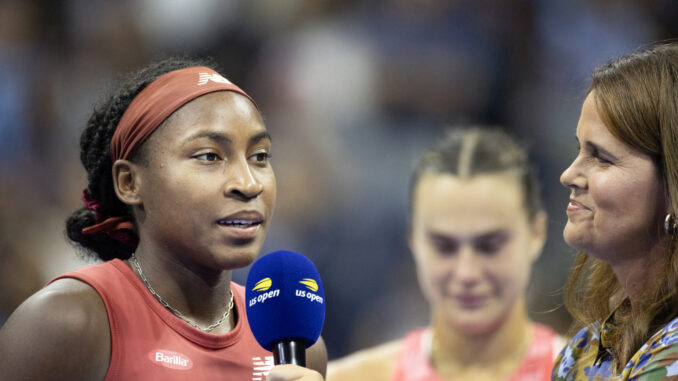
In the world of tennis, prodigies occasionally emerge, capturing the attention of fans and experts alike. Among these young talents is Coco Gauff, a player whose meteoric rise has ignited countless discussions and debates about the future of women’s tennis. Her journey from a promising youngster to a Grand Slam champion has been remarkable, but it is her potential, recognized at an incredibly young age, that continues to fascinate.
One notable figure who identified Gauff’s talent early on is Mary Joe Fernández. Fernández, a former tennis star and once a teenage sensation herself, has experienced the pressures and triumphs of early success in professional tennis. Her words about Gauff, spoken when the young athlete was just 13 years old, remain a testament to the promise seen in the prodigy long before she became a household name.
During a 2017 interview at the U.S. Open, Fernández, in discussing the exceptional abilities of young players, specifically mentioned Gauff. Her statement, “So can Cori Gauff. She’s 13 years old,” was brief but powerful. It highlighted a recognition of Gauff’s potential from someone who had walked the path of a young tennis star. Such an acknowledgment from a veteran like Fernández underscores how extraordinary Gauff’s abilities were, even as a young teenager. It’s a rarity for a seasoned professional to spotlight a 13-year-old, but Fernández’s words were prophetic, capturing the essence of a young girl destined for greatness.
Mary Joe Fernández’s own journey into the world of tennis began early. Born in the Dominican Republic and raised in the United States, she made a mark in tennis history on February 5, 1985. At the age of 13 years and six months, Fernández became the youngest player to win a WTA Tour match, defeating Candy Reynolds 6-0, 6-0 at the Lipton Championships. This victory not only set a record but also showcased Fernández’s precocious talent. Her early success set a standard for young players and offered a roadmap for those who followed, including Gauff.
Coco Gauff’s trajectory in tennis has been nothing short of extraordinary. The tennis world first took serious notice of her at Wimbledon in 2019 when, at just 15 years old, she defeated Venus Williams in the first round. This victory was not only a significant milestone in Gauff’s burgeoning career but also a symbolic moment. Venus, along with her sister Serena Williams, had long been inspirations for Gauff. Reflecting on her early years, Gauff mentioned that she primarily watched Serena Williams’ matches, admitting, “I really only watched like Serena up until probably like eight years old, and that’s when I started watching other players.” For a young Gauff, defeating Venus was more than just a win; it was a realization of a dream, a testament to her hard work and the impact her idols had on her development.
As Gauff’s career progressed, she continued to demonstrate her capabilities on various stages. By 2023, she reached a new peak by clinching her first Grand Slam title at the U.S. Open. This achievement solidified her status as one of the sport’s brightest stars, affirming the early predictions made by Fernández and others. Gauff’s powerful backhand, speed, and athleticism have been pivotal in her success. However, like all great athletes, she continues to evolve and refine her game.
Mary Joe Fernández, always an insightful commentator on tennis, has noted areas where Gauff could further improve. In a 2023 interview, Fernández suggested that Gauff might benefit from taking a short break to work on her forehand. She emphasized that “taking six months off, eight months off wouldn’t be the end of the world for her.” This statement reflected Fernández’s belief that by refining her forehand, Gauff could transform it into a potent weapon, complementing her already formidable serve and backhand. It’s a reminder that even the most talented athletes have areas to hone and that taking time to focus on development can lead to greater long-term success.
The parallels between Fernández and Gauff are striking. Both achieved significant milestones at a young age, navigating the unique challenges and pressures of early success in professional tennis. Fernández’s early achievements set a precedent, paving the way for young stars like Gauff. Her insights into Gauff’s development are deeply informed by her own experiences, providing a valuable perspective on the journey of a young tennis prodigy.
As of early 2025, Gauff’s performance continues to impress and inspire. She advanced to the quarterfinals of the Australian Open, showcasing her resilience and ability to overcome challenges. Each match reflects her blend of innate talent, rigorous training, and a remarkable capacity for growth and adaptation. Her story serves as a beacon for aspiring athletes, demonstrating that with talent, hard work, and the right mentorship, the possibilities are limitless.
The tennis community remains enthralled by Gauff’s evolution. Her journey is a powerful narrative of how natural ability, when nurtured with the right guidance, can lead to extraordinary accomplishments. As she continues her career, the wisdom and experiences of former players like Fernández will offer invaluable guidance, helping her navigate the complexities of professional sports.
In conclusion, Mary Joe Fernández’s early recognition of Coco Gauff’s talent underscores the cyclical nature of tennis, where each generation inspires and informs the next. Gauff’s journey, marked by early achievements and continuous development, serves as an enduring inspiration to young athletes worldwide. Her story highlights the importance of mentorship, the relentless pursuit of excellence, and the impact of recognizing and nurturing talent from a young age. As Gauff’s career unfolds, her legacy will likely inspire future generations, just as Fernández’s acknowledgment inspired her.
Leave a Reply